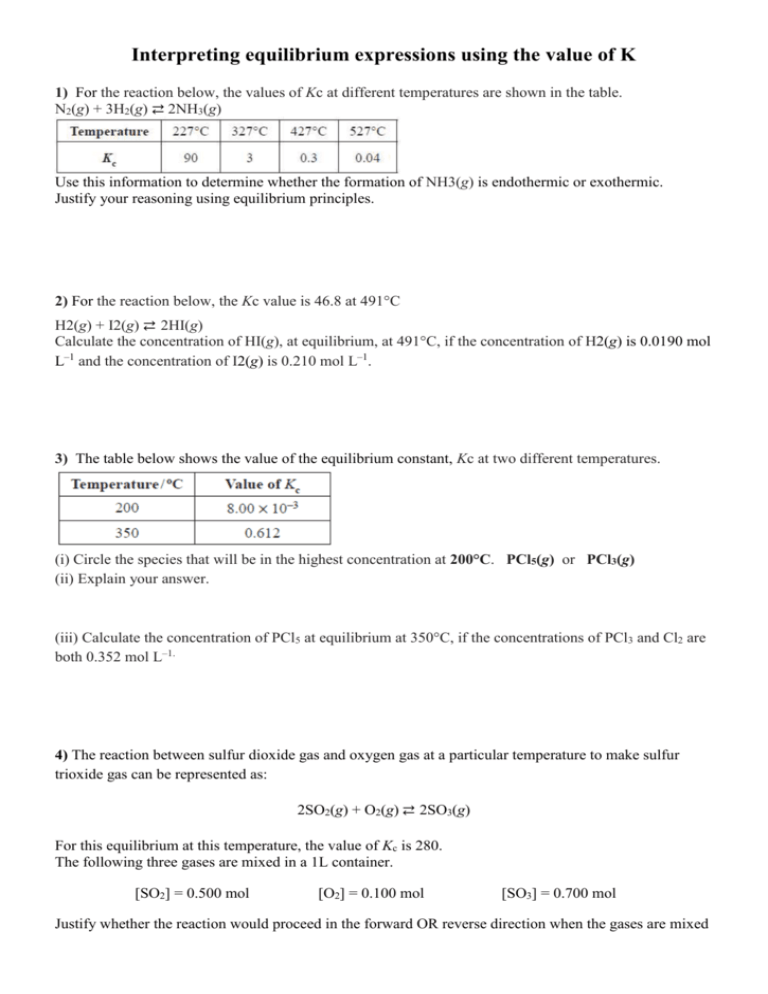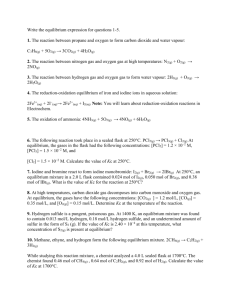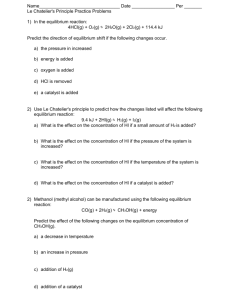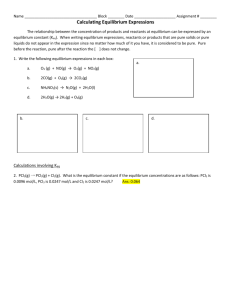interpretingequilibrium - chemicalminds
advertisement

Interpreting equilibrium expressions using the value of K 1) For the reaction below, the values of Kc at different temperatures are shown in the table. N2(g) + 3H2(g) ⇄ 2NH3(g) Use this information to determine whether the formation of NH3(g) is endothermic or exothermic. Justify your reasoning using equilibrium principles. 2) For the reaction below, the Kc value is 46.8 at 491°C H2(g) + I2(g) ⇄2HI(g) Calculate the concentration of HI(g), at equilibrium, at 491°C, if the concentration of H2(g) is 0.0190 mol L–1 and the concentration of I2(g) is 0.210 mol L–1. 3) The table below shows the value of the equilibrium constant, Kc at two different temperatures. (i) Circle the species that will be in the highest concentration at 200°C. PCl5(g) or PCl3(g) (ii) Explain your answer. (iii) Calculate the concentration of PCl5 at equilibrium at 350°C, if the concentrations of PCl3 and Cl2 are both 0.352 mol L–1. 4) The reaction between sulfur dioxide gas and oxygen gas at a particular temperature to make sulfur trioxide gas can be represented as: 2SO2(g) + O2(g) ⇄ 2SO3(g) For this equilibrium at this temperature, the value of Kc is 280. The following three gases are mixed in a 1L container. [SO2] = 0.500 mol [O2] = 0.100 mol [SO3] = 0.700 mol Justify whether the reaction would proceed in the forward OR reverse direction when the gases are mixed 5) The following reaction can be used to produce gaseous methanol, CH3OH, from carbon monoxide and hydrogen. CO(g) + 2H2(g) ⇄ CH3OH(g) ΔrH = –90.7 kJ mol–1 At 25°C, the equilibrium constant, Kc = 2.20 × 10–4. Explain what this indicates about the relative amounts of reactants and product at equilibrium. 6) Hydrogen gas and iodine vapour are placed in a sealed container at 445°C. These gases combine to form hydrogen iodide gas. This equilibrium can be represented by: H2(g) + I2(g) ⇄ 2HI(g) colourless purple colourless (a) Describe how an observer would know that the system had reached equilibrium. (b) At 445°C, the equilibrium constant Kc = 49.5. Name the species that will be in the highest concentration at this temperature. You may name one, or more than one species in your answer. Explain your answer. (c) When the temperature of the equilibrium system is raised from 445°C to 1000°C (at constant pressure), the value of Kc decreases. Use this information to determine whether the reaction between hydrogen and iodine is exothermic or endothermic. Justify your reasoning. 7) Nitrogen monoxide gas reacts with oxygen gas to form nitrogen dioxide gas. The equilibrium reaction can be represented by: 2NO(g) + O2(g) ⇄ 2NO2(g) colourless colourless brown At 230°C the equilibrium constant for this reaction has a value of 6.44 × 105. State which gas will be in the highest concentration at 230°C. Explain your answer in terms of Kc and the colour seen. 8) At 25°C the value of Kc is 1.70 107. Circle the species that would be present in the higher concentration in the equilibrium mixture at this temperature. Justify your choice. Ag+(aq) Ag(NH3)2+(aq) or 9) At 200°C the value of Kc is 1.10 10–5. Circle the species that would be present in the higher concentration in the equilibrium mixture at this temperature. Justify your choice. NO2(g) or NO(g) © 2014 http://www.chemicalminds.wikispaces.com NCEA questions and answers reproduced with permission from NZQA









